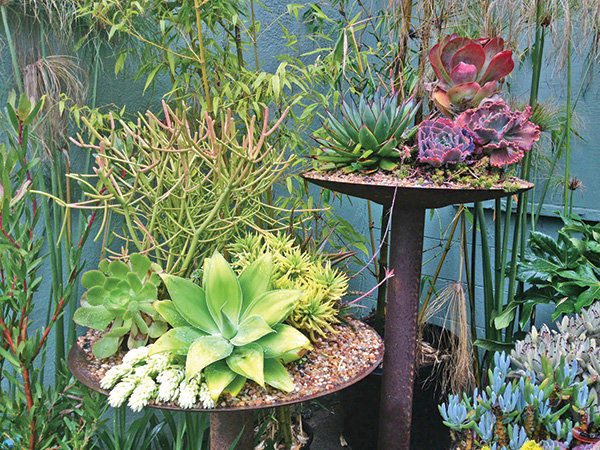Has the hot, dry, windy weather made your garden look like mid-summer? Our meager spring rains have all but disappeared from the soil and what hasn’t evaporated the weeds have taken. The local water companies all have water conservation requirements that began last month. I’m getting lots of calls and emails asking for advice about the best way to use water efficiently so the garden doesn’t look like the Sahara this summer. I’m helping others redesign their gardens with an eye towards ongoing water conservation.
Conserving water is now a way of life. This doesn’t mean you need to let your valuable trees and shrubs die. Water smarter with an efficient irrigation system set to run less often and encourage deeper rooting. It’s a good time to reduce the size of the lawn, or better yet, replace it with a low-water substitute and get a rebate.
Allocate your water budget wisely. Pay attention to which plants are doing well and which aren’t. Be realistic about plants that don’t suit the conditions you have to offer. Remove them and replace them with plants that have proven themselves adaptable and are well-suited to your own garden. The key to preserving the earth’s resources is to choose the right plant for the right place.
Many of your most successful plants can manage on a lot less water than you think. These may be California natives or water-wise Mediterranean or Australian plants that perform well here. Plan now. Any new plant, even if its drought tolerant, requires some irrigation to get established, so maybe postpone that big garden planting until after mid-September when the weather is cooler, but the soil is still warm, which encourages rooting.
We gardeners will always find a way to enjoy our outdoor space. A plant in a pot doesn’t require much care and is easy to water. An interesting plant combination that will thrive in tough conditions is the burgundy, grass-like festival cordyline planted with leucodendron discolor. The burgundy foliage of the festival grass looks great combined with the red and yellow flowers of the leucadendron. Both of these plants require little water once established.
Succulent gardens are another fun way to have a garden and conserve water at the same time. Picking your planter is fun and during the winter you can cover or move the planter for frost protection, so you can choose some of the more colorful but tender succulents.
As a reminder, many common garden plants that you normally consider not very drought tolerant like, camellia, require only a deep watering every 10 days or so in the growing season. Modest, fuzzy little lamb’s ears grow happily in sun or shade and any kind of soil. Stachys byzantina ‘silver carpet’ grows only 12″ tall, blooms with purple flowers and spreads to make a beautiful edging or low border that is very drought tolerant.
Elfin thyme is the perfect groundcover. It’s a good lawn substitute for an area that gets only light foot traffic. Gorgeous when in bloom with light pink flowers in summer, it will cover dry slopes, fill in between stepping stones or creep over a rock. Elfin thyme likes good drainage and is very drought tolerant. In fact overwatering will impair growth.
I also recommend old favorites such as Jerusalem sage, gray or green santolina, low and upright forms of rosemary, manzanita and ceanothus as well as California fuchsia, scaevola and homestead verbena. Low-water-use plants can be colorful as well as gentle on the water budget.











